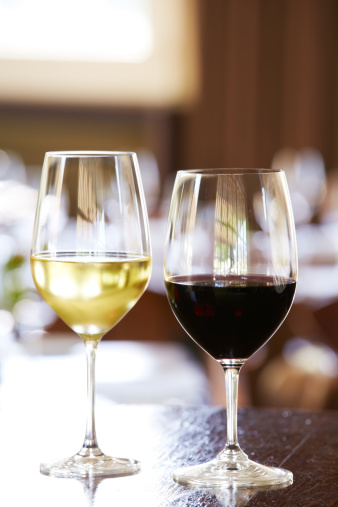
Sulfites, tannins, resveratrol—if you’ve read anything about wine, you’ve probably come across at least one of these terms. But what does all the fancy verbiage mean for your health? We asked Jim Harbertson, PhD, associate professor of enology (that is, the science of wine) at Washington State University, to decode the lingo commonly found on bottle labels so you know exactly what you’re drinking, and how it affects you, beyond a nice buzz.
Sulfites
What it means: “Sulfites are normally added to wine to protect it from oxidation or unwanted microbial growth,” Harbertson says. In other words, they keep wine fresh and prevent it from morphing into vinegar. Sulfites have developed a bad rap for causing allergic reactions like sneezing and headaches, but in reality, only a small portion of the population exhibits a sensitivity or allergy to them. There’s also some indication that they trigger symptoms for asthmatics, but the relationship between worsened asthma symptoms and sulfites isn’t totally clear, Harbertson says. You’ll spot “contains sulfites” on wine bottles because the U.S. Food and Drug Administration (FDA) requires that labeling when any food contains more than 10 parts per million of sulfites, but for most people, they’re nothing to worry about. Know for sure you’re allergic? Look for the words “sulfite-free” on labels.
Histamine
What it means: The nitrogen-based compound is a common allergen found in foods and can cause an inflammatory response. (It’s also, confusingly, the name for a substance our bodies release when they’re having an allergic reaction.) Histamines sometimes crop up in wines that undergo a second fermentation to smooth out their acidity and texture, Harbertson explains. Unfortunately, it’s nearly impossible to tell which wines undergo this process and which don’t without checking with the winemaker, though some bottles are now labeled as not undergoing malolactic fermentation, meaning they should be histamine-free, Harbertson says). The good news: “There really isn’t any definitive research that demonstrates that the histamines in wine cause human health problems,” Harbertson says.
Tannins
What it means: You know that dry feeling you get on your tongue after sipping certain kinds of vino? That astringent sensation is caused by tannins, a type of polyphenol that get produced during the winemaking process, mostly from grapes. While these micronutrients may be disease-fighting when consumed in certain forms and foods, when imbibed in wine, “these natural compounds tend to get bound up in salivary proteins and proteins in the human digestive system, so their health benefits are somewhat limited,” Harbertson says. Tannins are most often found in big, full-bodied red wines—look for labels bearing the names Bordeaux, Shiraz, Barolo, or Barbaresco.
Resveratrol
What it means: You may have seen this buzzy antioxidant, found in the skin of grapes listed on the packaging of beauty serums and creams touting its anti-aging properties. You’ll be hard-pressed to find a wine label doing the same. “Based on current studies, it’s not clear that there’s a health benefit [of drinking it] because the resveratrol concentration in wine is low,” Harbertson says. Want to try to load up on resveratrol, just in case? Know that there’s likely a higher concentration of it in red wines versus white. But that’s still no reason to drink more than the recommended one glass a day.
Heavy metals
What it means: Okay, this one’s not listed on any label, but you might have heard about these being linked to wine anyway. Heavy metals are metals and metal compounds that can adversely affect our health when consumed in the right (or wrong, as the case may be) doses. A study published in the Chemistry Central Journal indicated that some wines have showed concerning levels of heavy metals such as copper and manganese. However, according to Harbertson, “the FDA has been monitoring heavy metals in wine and has indicated that concentrations are lower than would require regulation.” Cheers to that!
Organic and biodynamic
What they mean: Organic winemakers refrain from using pesticides and other chemicals in their growing and production methods, and they don’t add sulfites as preservatives. Biodynamic vintners start with these same organic practices, but they also consider the whole ecosystem of the vineyard in growing their grapes, including more obscure factors such as lunar cycles. While Harbertson says he’s all for producing wine that’s environmentally sustainable, he also notes, “there’s not enough information at this point on the human health impacts of biodynamic and organic grapes and wine” to say that the practice is actually good for us.
Low-alcohol
What it means: This hot phrase has been all over wine labels lately. The benefits of low-alcohol wine include getting less drunk with each glass, lower cost per bottle, and a lighter taste. It’s lighter on calories, too: Though the relationship between booze and calorie intake is complex—“alcohol is not converted to energy like other things you consume and, therefore, doesn’t get stored as other calories will,” says Harbertson—alcohol is the primary source of calories in wine, so low-alcohol wine will have fewer of them than bottles with a higher content.
This article originally appeared on Health.com.
More from Health.com:
More Must-Reads from TIME
- Where Trump 2.0 Will Differ From 1.0
- How Elon Musk Became a Kingmaker
- The Power—And Limits—of Peer Support
- The 100 Must-Read Books of 2024
- Column: If Optimism Feels Ridiculous Now, Try Hope
- The Future of Climate Action Is Trade Policy
- FX’s Say Nothing Is the Must-Watch Political Thriller of 2024
- Merle Bombardieri Is Helping People Make the Baby Decision
Contact us at letters@time.com